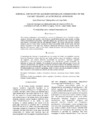Please use this identifier to cite or link to this item:
https://accedacris.ulpgc.es/jspui/handle/10553/106130
| DC Field | Value | Language |
|---|---|---|
| dc.contributor.author | Monterroso, O. | en_US |
| dc.contributor.author | Riera, Rodrigo | en_US |
| dc.contributor.author | Núñez, J. | en_US |
| dc.date.accessioned | 2021-03-23T12:46:31Z | - |
| dc.date.available | 2021-03-23T12:46:31Z | - |
| dc.date.issued | 2012 | en_US |
| dc.identifier.issn | 1679-8759 | en_US |
| dc.identifier.uri | https://accedacris.ulpgc.es/handle/10553/106130 | - |
| dc.description.abstract | The Canarian archipelago is characterized by a mosaic of soft-bottoms such as Cymodocea nodosa meadows, Caulerpa spp. meadows, mäerl bottoms, sabellid fields and bare sandy seabeds, including various macroinfaunal communities. Vegetated habitats (e.g. Cymodocea and Caulerpa) maintain more diverse communities than the non-vegetated seabeds. The results indicated that Caulerpa meadows and, to a lesser extent, Cymodocea nodosa and sabellid fields are the richest and most diverse ecosystems in the study area. Moreover, biodiversity differences among islands could be detected with maximum values on the eastern islands (Lanzarote and Gran Canaria) and lowest values on the western ones (La Palma). | en_US |
| dc.description.abstract | O arquipélago das Canárias é caracterizado por um mosaico de fundos inconsolidados contendo bancos de Cymodocea nodosa, Caulerpa spp., fundos calcários, bancos de sabelídeos e sedimento não biogênico, que abrigam diferentes comunidades da macrofauna. Ambientes vegetados (Cymodocea e Caulerpa) possuem comunidades mais diversificadas quando comparados aos ambientes de fundos não vegetados. Os resultados do presente estudo indicaram que os bancos de Caulerpa, primeiramente, e em seguida os bancos de Cymodocea nodosa e de sabelídeos, formam os sistemas mais ricos e diversificados da área. Além disso, puderam também ser detectadas diferenças de biodiversidade entre as ilhas do arquipélago, sendo os valores mais altos localizados nas ilhas ao leste (Lanzarote e Gran Canaria) e os menores nas ilhas à oeste (La Palma). | en_US |
| dc.language | eng | en_US |
| dc.relation.ispartof | Brazilian Journal of Oceanography | en_US |
| dc.source | Brazilian Journal of Oceanography [ISSN 1679-8759], v.60 (1), p. 1-9 | en_US |
| dc.subject | 251005 Zoología marina | en_US |
| dc.subject.other | Soft-bottoms | en_US |
| dc.subject.other | Meadows | en_US |
| dc.subject.other | Cymodocea | en_US |
| dc.subject.other | Caulerpa | en_US |
| dc.subject.other | Macrofauna | en_US |
| dc.subject.other | Canary Islands | en_US |
| dc.subject.other | Atlantic Ocean | en_US |
| dc.title | Subtidal soft-bottom Macroinvertebrate communities of the Canary Islands. an ecological approach | en_US |
| dc.type | info:eu-repo/semantics/article | en_US |
| dc.type | Article | en_US |
| dc.identifier.doi | 10.1590/S1679-87592012000100001 | en_US |
| dc.identifier.scopus | 2-s2.0-84861706902 | - |
| dc.contributor.orcid | #NODATA# | - |
| dc.contributor.orcid | #NODATA# | - |
| dc.contributor.orcid | #NODATA# | - |
| dc.description.lastpage | 9 | en_US |
| dc.identifier.issue | 1 | - |
| dc.description.firstpage | 1 | en_US |
| dc.relation.volume | 60 | en_US |
| dc.investigacion | Ciencias | en_US |
| dc.type2 | Artículo | en_US |
| dc.identifier.external | 12829626 | - |
| dc.description.numberofpages | 9 | en_US |
| dc.utils.revision | Sí | en_US |
| dc.identifier.ulpgc | No | en_US |
| dc.contributor.buulpgc | BU-BAS | en_US |
| dc.description.sjr | 0,284 | |
| dc.description.jcr | 0,603 | |
| dc.description.sjrq | Q3 | |
| dc.description.jcrq | Q4 | |
| dc.description.scie | SCIE | |
| item.grantfulltext | open | - |
| item.fulltext | Con texto completo | - |
| crisitem.author.dept | GIR ECOAQUA: Biodiversidad y Conservación | - |
| crisitem.author.dept | IU de Investigación en Acuicultura Sostenible y Ec | - |
| crisitem.author.dept | Departamento de Biología | - |
| crisitem.author.orcid | 0000-0003-1264-1625 | - |
| crisitem.author.parentorg | IU de Investigación en Acuicultura Sostenible y Ec | - |
| crisitem.author.fullName | Riera Elena, Rodrigo | - |
| Appears in Collections: | Artículos | |
SCOPUSTM
Citations
6
checked on Jun 8, 2025
WEB OF SCIENCETM
Citations
6
checked on Jun 8, 2025
Page view(s)
103
checked on May 23, 2024
Download(s)
60
checked on May 23, 2024
Google ScholarTM
Check
Altmetric
Share
Export metadata
Items in accedaCRIS are protected by copyright, with all rights reserved, unless otherwise indicated.
